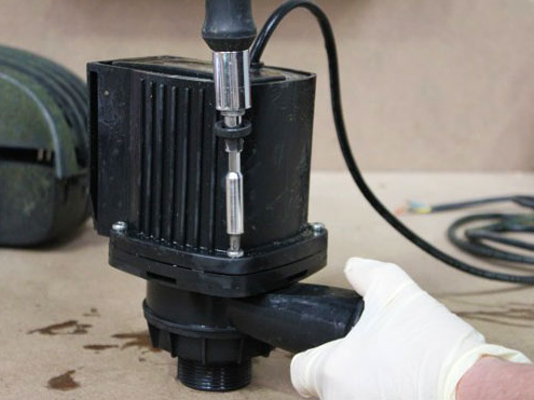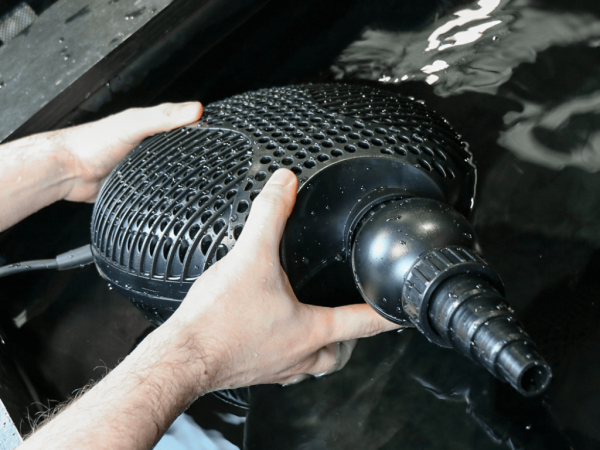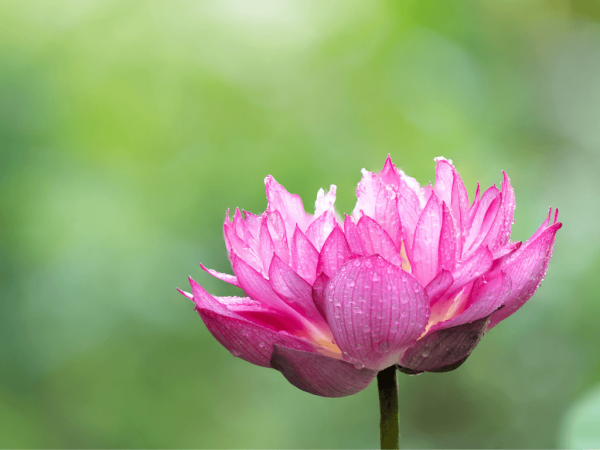Is your pond pump not working? Repair is easier than you think!
What are the signs of a pump that requires maintenance or repair?
Repairing and maintaining your pond pump can sound like an intimidating task. Luckily, the process is straight forward, once you've got the hang of the standard maintenance steps.
Usually your pump will have stopped working because of something simple. For example, a blockage inside the pump is arguably the most common reason. This is often caused by a pesky twig, a pile of debris, leaves or a build-up of blanket weed... And generally these things can be prevented with simple pond pump maintenance. A bit of cleaning and care is best recommended, but in rare circumstances, this can be out of our control. Therefore, pond pump repair is required.
Your pond pump is running fine, only to suddenly stop working at the most awkward time.
Before you dive into your pond, remove the pump and return it to where it was originally purchased - there are several steps we suggest before resorting to sending back the pump to the supplier.
Pond pump maintenance is not something you leave for an expert. Basic understanding of the pump you have purchased is required, and straight forward. Cleaning the pump is the best possible way to avoid common problems with your pond pump.
Here at Swell, we sell hundreds of pond pumps every week. Our Returns Team receive a dozen pumps sent back from customers who think their product is not working. 9 times out of 10, the pump is working perfectly fine, and the whole issue could have been resolved with some simple maintenance.
Pond pump repair is easier than you think
Swell returns manager Phil Cross tests and services all pond pumps that are sent back for inspection. For the most part, he can repair any issues in two minutes with a screwdriver and some paper towels. Pond pump repair ironically isn't an actual repair - more like "pond pump spot maintenance."
Phil explained: "Pond pump repair really isn't that complicated. When a pump stops working, it's usually because of one of two things. Either the owner has a problem with their electricity supply, or they haven't bothered to do any basic maintenance on their pump."
Check your electricity supply
The power source can be an issue that is easily resolved as well. Pond pumps are designed to be used outdoors, therefore they do not come with a 3-pin plug like standard appliances sold on the UK market.
Your pond pump is an outdoor-based product powered by electricity. Therefore, you should always invest in a Residual Circuit Detector (RCDD). This ensures the correct and safe installation of your pump, and is strongly suggested for all outdoor electric based products.
Phil said: "A common problem in pond pump repair and diagnosis is with the cable. People bury them underground and then accidentally cut through them. Your wiring must always be protected. If you have multiple appliances, using a switchbox is highly recommended. Swell UK offers the Blagdon Powersafe Switch Box, designed to run a maximum of 5 appliances.
If you have not found a problem with your electrics or wiring, and your pond pump is still not working, this is where maintenance comes into play. Phil said: "It doesn't matter how good a pond pump is - they will always let in particles or debris from your pond. Over time, these particles act like sandpaper and become an abrasive on your rotor. Some basic spot cleaning resolves this issue easily."
Pond pump repair: A simple guide
How do you go about pond pump repair and maintenance? Phil let us into his workshop and explained. "Start by checking the power supply, then the cable, then the pump." As Phil took us through the stages of running diagnostics, he showed us one pump that had been sent back by a customer. He unboxed an Oase Eco Max 4000 - a top of the range pump, but even a top of the range pump needs a little TLC.
"Straight away I can see they have a problem with blanket weed," said Phil. Upon inspection, the pump's outer casing is a striking shade of green. It stands to reason - blanket weed in the pond, equals blanket weed in the pump. Something that does not make for happy running.
When maintaining and checking the pump, it is important to ensure the product is disconnected from any power supply. With a few turns of the screwdriver, Phil opened the case to reveal the pump inside.
You can easily check for any simple blockages. This pump is pretty clean, so maybe the problem is inside the motor housing. Checking inside the case, both ends appear to be clear of twigs and grit. Therefore, we need to check out the rotor chamber and impeller.
"First you have to check for any blockages in the chamber. Pumps will suck in anything floating around in your pond water. For example, if you have overhanging leaves, berries or twigs, these can find their way to blocking the chamber."
Phil removes the rotating impeller and checks the chamber for any debris caught inside the pump itself. Luckily, this model appears to be free from any blockages that could restrict the impeller.
Phil wipes the impeller magnet, removing any mud or slime that may be present. He can then check the impeller for any scoring, which usually occurs when sediment is caught inside the chamber. When the impeller rotates, this will catch against a small piece of debris, resulting in scored lines appearing across the magnet. This can cause the pump mechanism to fail. Therefore, it is best recommended to regularly check the chamber when maintaining the pump.
Pumps working with Filtration Systems
When your pump is working in conjunction with a filtration system, it is advised to also check your pond filter and ensure this is kept clean. If the filter contains a sponge or a natural pre-filter, this will need to be maintained and kept clean.
If your filter is clogged with mud, this will restrict the flow of water from your pump. It will struggle to push water through your filtration system. We've previously seen pond pump returns which the unit is so badly clogged, the motor will fail and burn out. When this occurs due to a lack of maintenance, it's not covered under the manufacturer warranty.
Similarly, if you purchase a combined pond pump, filter and UV unit, make sure you check inside to see if there are any plastic bags still present on the media. Some suppliers place biological filter media in plastic bags, which counts as packaging for the product. It is vital you remove these. Otherwise, they can block the flow of water and cause the pump to break.
When disassembling the pond pump, the impeller is arguably the most fragile component. Phil said: "The impeller (also known as rotor) is particularly prone to blockages in the south of England. They have quite hard water that is chalky and causes limescale on the rotor. It becomes like a cement and makes it difficult for the rotor to do its job properly."
Limescale can be removed by soaking the pump in white vinegar, or by purchasing a pump clean product such as the Oase AquaActiv Pump Clean. This is a treatment designed to remove limescale and other deposits, and is an alternative to using white vinegar.
Importance of maintaining your Pump regularly
Phil puts the pump back together, drops it into his testing pond. After cleaning and checking the pump, it now works perfectly fine. If the customer had followed the basic steps of maintaining their pond pump. this whole process could have been prevented with some simple steps.
"Another thing you should remember," he said, "is to always test your pump with it fully submerged in water. Many pumps will not run dry, and are submersible. Some pumps like the Oase range have a sensor that stops them from working if another device in the pond has an electrical problem."
Phil concludes that prevention is better than cure in pond pump repair.
He said: "9 out of 10 pumps we receive back have stopped working because they have not been maintained correctly. Usually, this is because they have not looked after their filtration system either."
Phil reiterates that it does not matter how good a pump is - if you do not maintain it, expect problems.
He said: "Oase have always been the Rolls Royce of pond pumps. Then you have your Blagdon, Hozelock, Fishmate and now Bermuda. They all get sent back to us because they all require maintenance. When maintaining the garden or checking the pond, every few weeks, clean out the pump and check the filter. You will save yourself a lot of problems in the long term. Maintaining your pond equipment is vital, especially for fish keepers. If you choose to neglect these products, you endanger your live-stock.
For example, sending back your pump will leave your pond without any circulation. Therefore, in order to avoid this, it is best recommended to follow simple maintenance steps. Pond pump repair is often a case of "a stitch in time saves nine."
Pond pump repair components are available via the Swell UK website. It is highly recommended to keep spares of any consumable components, such as pond pump impellers. You can view the available accessories we stock for pond pumps via our website on the Accessories webpage.










any ideas how to clear an airlock?? Pump working but erratic flow.
Any suggestions?
Cheers Phil
I have a Blagdon pump which has lost power and shifts about 1/2 as less . I have gone through all the stages - cleaned the impellor shaft of limescale , checked for blockages etc . Its really stumping me - any ideas?
How old is the pump? Since you have cleaned it well it might just be a case of old age. Phil says all he can recommend other than that is to check the power supply.
Hello. I have a Tsurumi 50PN2.4S pump for my waterfalls It has been giving me "white water" falls for 7 years now. This year the flow has decreased to just a trickle. I clean and check for debris but its clean. I unplug it and then restart it and it flows better for a day or so then slows down again. Something I can fix? Expert to fix or better to just get a new pump? Thanks Mike
Check the power supply and check the impeller to make sure it’s not worn. If it is the impeller it might be possible to buy a new part for it. But it does sound as though it might be worth buying a new pump entirely. From what I’ve read, it seems as though this particular model usually lasts for about 4 years or so before any problems arise, so since you’ve had yours for 7 years it sounds as though you’ve had a good run!
I have an Aquamax 10000 that when powered on, the impeller doesn't spin, however, if I encourage it with my finger it runs - it has been suggested that it may be a 'run capacitor' that needs changeling - does this sound feasible ? Is this part easy to change ?
Regards
How do I get the rotor out?
Kenneth
Kenneth
Kenneth
Paul
It's probably best if you give us a call on 0161 351 4700. One of our advisors can have a chat to you about this and give you an email address to send us a photo over. If you bought the product from us we could also have a look on our system to find out which model it is.
This sounds like an electronic failure within the pump, possibly due to faulty thermal cut-off. It is best to contact your retailer for repair or replacement under warranty.
I have an Oase AquaMax RB 16000 pump (roughly 3 years old)in which the rotor jammed. I have now managed to get the rotor/impeller turning again, but was not able to extract the rotor to clean it. The pump is now running fine (apparently)but I'd like to be able to get the rotor out to see what jammed it in the first place. Any suggestions as to techniques that might help?
You need to remove the strainer cage to access the motor; the intake should now be visible and this unscrews from the front of the motor giving access to the impeller. The impeller need only be gently pulled for removal.
You need to remove the strainer cage to access the motor; the intake should now be visible and this unscrews from the front of the motor giving access to the impeller. The impeller need only be gently pulled for removal. The lights should not affect the impellor.
ps has Matt D solved his problem I wonder
thank you
It there a run /pressure sensor that could be faulty, or do you know of any other issues that may cause this that could be repaired.
It sounds like the kind of problem that may be difficult to resolve yourself. Did you buy it from us? And how long have you had if for? If the standard warranty has run out, it may be covered by the manufacturer's warranty. Feel free to give us a call on 0161 351 4700, and one of our advisors can chat to you about it.
Is it worth my repairing? Can I buy a spare Impeller Assembly to replace it? Do you stock them or know who does.
My address is in Exeter, Devon
Thank you
How old is the pump? Is it still within warranty? We don't sell this product ourselves unfortunately, but it sounds as though it may need a new impeller or replacing all together.
Look forward to hearing from you, thanks
Eddie Lopez
Thanks
Eddie Lopez
I have spoken to our pond advisor and he has suggested that the pump is likely to be broken. If it is within warranty, you should contact the retailer for a replacement. If not feel free to look at our pumps here (http://www.swelluk.com/pond/pond-pumps-62.html) or call us for advice on 0161 351 4700.
I am following your helpful guide to get my oase aquamax eco 16000 pump running again. How do you remove the rotor? (looks easy on the photos!)
Thanks
Mark
You may need a screwdriver to remove the intake in front of the impeller. Once the impeller is visible, grasp it and pull - then it should come free.
It depends which Oase pump you have, Some are electronically dimmable, some have a built in flow control and others require a ball valve. Call us on 0161 351 4700 if you need help identifying which one you have.
Please help
Many thanks
This is probably a failed sensor which isn't available separately as far as I am aware. Equally it could be a loose wire in the light. We wouldn't recommend taking apart the electrics of the pump so you could either buy a new pump to have a working light or maybe buy a separate pond light set however pond light sets will not have a sensor.
Have you checked the rotor/impeller for any blockages?
Unfortunately we do not stock the Oase Nautilus so can not check, we stock a newer version. The current version uses normal Phillips screws but it is possible the older model (your model) uses star drives which should be readily available at any DIY store. You may be looking at security screws which look like star drives but have a dimple in the centre - these are used to prevent access so you may be looking at the wrong area.
You may be best contacting Oase for advice on this one one 01264333225.
Any ideas what has gone wrong it is almost two years old
It is probably a clogged up or worn impeller. You will need to access and remove the impeller to inspect and clean. If clogged - cleaning should do the trick, if worn you will need to purchase a new impeller (12 month warranty on impellers) which you can find here: http://www.swelluk.com/pond/pond-pumps-62/fountain-pumps-293/fish-mate-pond-pump-service-kits-154884.html.
If the impeller is clean and unworn but the problem persists, this may be a fault with the motor itself and you will have to contact your retailer if it is within warranty.
You need to remove the impeller and check for wear and damage. If worn, check the impeller tube (where the impeller sits) for similar damage. If only the impeller is damaged or worn then a new one can be purchased here:
http://www.swelluk.com/pond/pond-pumps-62/fountain-pumps-293/fish-mate-pond-pump-service-kits-154884.html
If both the impeller and housing are damaged or worn, you will likely need a new pump.
If just the impeller is worn or damaged, you may be able to purchase just an impeller. However, if the housing and impeller is damaged you will need a new pump altogether.
I have a oase eco 12000.Its stopped working ,when switched on it bleeps,and again when switched off.Have stripped it down to expose just the motor and the impeller.I seem to remember when I had trouble with my other pump of same make a flick with finger set it going ,this one appears to turn much more stiffly more than can be done by finger pressure.
Can you help
Thanks
You need to remove the impeller and check for wear and damage. If worn, check the impeller tube (where the impeller sits) for similar damage. If only the impeller is damaged or worn then a new one can be purchased. You will need to call us on 0161 351 4700 as we do not stock this item, but can get in touch with the supplier.
If both the impeller and housing are damaged or worn, you will likely need a new pump.
Hope that you can help, I have just noticed that the cable on my pump is perished pretty much every where, do you know if it is possible to replace the wires or is this just too risky,
Kind regards
Nicola
The wire on a pond pump is completely sealed which means you can't replace just the wire. Unfortunately, you probably need a new pump as this won't be easily repaired.
Our lotus diamond 220 stopped working and as you suggested we took it out and looks like a few seeds had managed to get in where the impeller is removed them and it is now working do you know if it is possible to get a new impeller? so we have a spare, have found a lotus impeller little gem for sale and wondered whether you would know if this would fit?
I have a OASE pump model AQUAMAX 8000 and I would like to replace the run capacitor but I can't read the reference to buy a nex one. Could you please tell me if you know the reference of the run capacitor please ?
Best regards,
Hope you can help,
Regards
Ron
I have an oase aquamax rb 16000 where the power cord is damaged nearby the pump.
I've removed the rotor and casing, but how to open the motor to replace the cable? From what I see they've build a specific tool to open it... Do you have another idea? Thanks!
Does anyone know where I can buy a new one
thanks paul